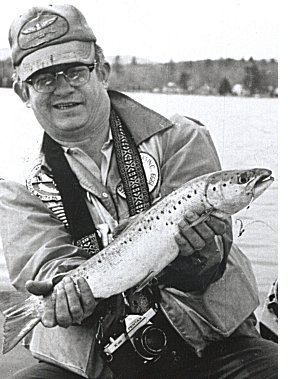Be Prepared for The Opening of Salmon Season

There is little doubt this will be the year for an early ice-out. With April 1st comes the opening of the landlocked salmon season in New Hampshire’s big lakes. It is a time many anglers anxiously awaited for. However, there is a big problem with the salmon population numbers and size that has our Fish and Game Department worried big time. Fisheries biologist, John Viar, says that cooperative efforts are needed to sustain quality coldwater fisheries in New Hampshire’s large lakes.
Enthusiastic anglers will be out in force on April 1 for the start of open-water fishing on the 15 lakes managed for landlocked salmon and lake trout. Fish and Game is asking those enjoying this popular fishery to help address a serious emerging issue. Fisheries Biologist, John Viar, stated that, “Over the past five years, we biologists have observed a dramatic increase in the occurrence of hook-wounded landlocked salmon in New Hampshire’s large lakes, including Winnipesaukee, Big Squam and Sunapee. Hook wounds noted were visible scars and tears of the jaw, throat and eye areas.”

Bob Harris with a 4½
pound landlocked salmon taken on a
Meredith Special tandem streamer while trolling
Wolfeboro
Bay on Lake Winnipesaukee. (Al Raychard
photo)
At Lake Winnipesaukee, from 2005 to 2009, landlocked salmon hook-wounding rates have doubled with the rate jumping from 15 to 30 percent of the catch. Additionally, in 2009, 27% of Lake Winnipesaukee-caught rainbow trout were hook-wounded. “Hook-wounded fish are stunted, shorter in length and lighter in weight than their non-hook-wounded counterparts. In heavily fished Lake Winnipesaukee, the increase in hook-wounding rate corresponds with a lack of larger, trophy-size landlocked salmon, lake trout and even rainbow trout and even larger specimens typically observed within each age group. This is a warning sign that fishing pressure, repeated catch and release, as well as harvest of the largest, healthiest coveted fish, may be reaching unsustainable levels,” Mr. Viar said.
Given the nature of New Hampshire’s large lakes, Viar says that yearling salmon and rainbow trout stocking rates must remain conservative to ensure growth to quality size. Each stocked fish is a finite resource, because of the limited annual crop of younger forage fish like rainbow smeltand white perch that sustain these predatory fish. “Anglers enjoy catching healthy, robust fish, so we must all work diligently and cooperatively to minimize the negative effects of hook-wounding by following these recommended guidelines,” Viar said. They are:
- Use extreme care when unhooking and releasing fish:
a. Have your tools ready to minimize release time.
b. NEVER shake a fish off the hook.
c. NEVER unhook a fish suspended in the air.
d. NEVER sharply pull hooks out while the fish is moving and twisting.
- Use rubber or other “fish friendly” landing nets. Rubber nets minimize stress, decrease unhooking and exposure time and prevents damage caused by traditional nets. Tackle is also much more easily removed. Turn the fish upside down in the rubber net to help calm it down while unhooking.
- All hook styles and sizes can cause damage. Fish size, hooking location and angler experience in executing proper release techniques are critical variables. Exercise caution to ensure future quality fisheries!
- Selectively harvest severely wounded fish. This should include fish with previous wounds. Healthy, lightly hooked and properly released salmon and trout, with no prior hooking injuries, have a much greater growth potential and a realistic chance of becoming tomorrow’s trophy.
- Consider limiting fishing time/trip duration. This is difficult to ask of anglers who have invested much time, money, effort and travel in pursuit of these magnificent fish, but it has become clear that even well-intended repeated catch and release is not advisable in these fragile fisheries.
Fisheries biologists have recommended these suggestions for several years now, but data trends clearly indicate that voluntary efforts alone have not been successful. Thus, regulatory or other management measures may ultimately be necessary to preserve the quality of New Hampshire’s large lake landlocked salmon and rainbow trout fisheries. “If we want quality fisheries in the future, fisheries biologists and anglers will have to work together on this problem. The sustainable enjoyment of a quality natural resource is indeed a fine balancing act,” John Viar, commented.
If you will be on the water for salmon in the big lakes this year, please follow the recommended guide lines. The situation may even require Fish and Game to set new limits on salmon, lake trout and rainbow trout within these lakes. Only time will tell. Tight lines.

Bob Harris can be
reached via e-mail at:
outwriter2@aol.com
Past
Columns by Bob Harris
>>>
About
Bob Harris
>>>
DISCLAIMER: The opinions
expressed by Mr. Harris are not necessarily those of the
Goffstown Residents Association or its members
Copyright©2010 Goffstown Residents Association. All Rights Reserved. |





